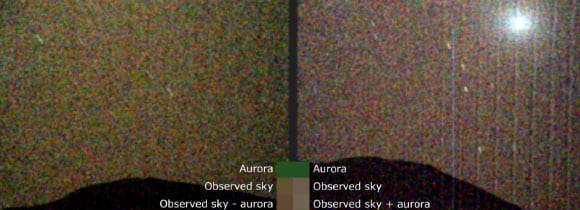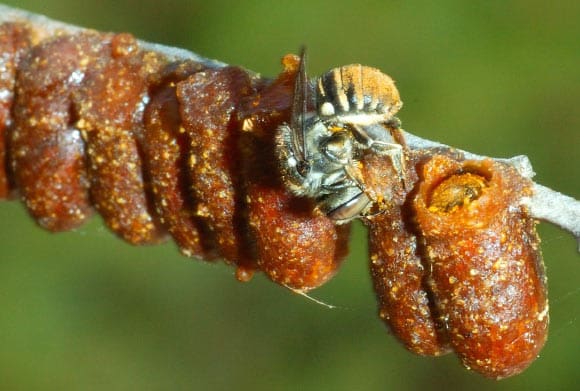Mars hosts various auroral processes despite the planet’s tenuous atmosphere and lack of a global magnetic field. To date, all aurora observations have been at ultraviolet wavelengths from orbit. In a new paper, planetary scientists describe the discovery of green visible-wavelength aurora, originating from the atomic oxygen line at 557.7 nanometers (nm), detected with the SuperCam and Mastcam-Z instruments on NASA’s Perseverance rover.

The first visible-light image of green aurora on Mars (left), taken by the Mastcam-Z instrument on NASA’s Perseverance rover. On the right is a comparison image of the night sky of Mars without aurora but featuring the Martian moon Deimos. The moonlit Martian night sky, lit up mostly by Mars’ nearer and larger moon Phobos (outside the frame) has a reddish-brown hue due to the dust in the atmosphere, so when green auroral light is added, the sky takes on a green-yellow tone, as seen in the left image. Image credit: NASA / JPL-Caltech / ASU / MSSS / SSI.
On Earth, aurorae form when solar particles interact with the global magnetic field, funneling them to the poles where they collide with atmospheric gases and emit light.
The most common color, green, is caused by excited oxygen atoms emitting light at a wavelength of 557.7 nm.
For years, scientists have theorized that green light aurorae could also exist on Mars but suggested they would be much fainter and harder to capture than the green aurorae we see on Earth.
Due to the lack of a global magnetic field, Mars has different types of aurorae than those we have on Earth.
One of these is solar energetic particle (SEP) aurorae, which NASA’s MAVEN mission discovered in 2014.
These occur when super-energetic particles from the Sun hit the Martian atmosphere, causing a reaction that makes the atmosphere glow across the whole night sky.
“Our discovery opens up new possibilities for auroral research and confirms that auroras could be visible to future astronauts on Mars’ surface,” said Dr. Elise Knutsen, a postdoctoral researcher at the University of Oslo.
On March 15, 2024, the Sun produced a solar flare and an accompanying coronal mass ejection.
This solar activity led to aurorae across the Solar System, including at Mars, where Perseverance made history by detecting them for the first time from the surface of another planet.
Dr. Knutsen and colleagues confirmed the detection using data from the SEP instrument onboard NASA’s MAVEN spacecraft and ESA’s Mars Express spacecraft.
“This was a fantastic example of cross-mission coordination,” said MAVEN principal investigator Dr. Shannon Curry, a researcher at the Laboratory for Atmospheric and Space Physics at the University of Colorado Boulder.
“We all worked together quickly to facilitate this observation and are thrilled to have finally gotten a sneak peek of what astronauts will be able to see there some day.”
By coordinating the Perseverance observations with measurements from MAVEN’s SEP instrument, the researchers could help each other determine that the observed 557.7 nm emission came from solar energetic particles.
Since this is the same emission line as the green aurora on Earth, it is likely that future Martian astronauts would be able to see this type of aurora.
“Perseverance’s observations of the visible-light aurora confirm a new way to study these phenomena that’s complementary to what we can observe with our Mars orbiters,” said Dr. Katie Stack Morgan, acting project scientist for Perseverance at NASA’s Jet Propulsion Laboratory.
“A better understanding of aurorae and the conditions around Mars that lead to their formation are especially important as we prepare to send human explorers there safely.”
The team’s paper was published in the journal Science Advances.
_____
Elise W. Knutsen et al. 2025. Detection of visible-wavelength aurora on Mars. Science Advances 11 (20); doi: 10.1126/sciadv.ads1563


